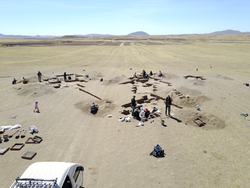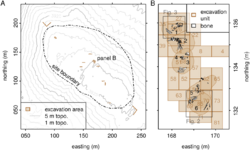Engineering:Wilamaya Patjxa
| Alternative name | Ilave 13014 |
|---|---|
| Location | Mulla Fasiri, Puno, Peru |
| Region | Ilave Basin, Lake Titicaca Basin, Andean Altiplano |
| Coordinates | [ ⚑ ] : 16°12′S 69°42′W / 16.2°S 69.7°W |
| Altitude | 3,925 m (12,877 ft) |
| Type | open-air seasonal residential site |
| Area | 1.6 ha |
| History | |
| Founded | 9,000 BP.[1] |
| Periods | Early to Middle Archaic periods |
| Cultures | Ancestral Aymara[2] |
| Associated with | foragers (a.k.a., hunter–gatherers) |
Wilamaya Patjxa[3] is an ancestral Aymara[4] archaeological site located on the Andean Altiplano in the Lake Titicaca Basin, Puno, Peru. Mobile forager populations occupied the high-altitude (3,925 m) site approximately 9,000 years ago. The site represents the earliest directly dated evidence of human occupation of the Titicaca Basin and thus offers insights into the behaviors and practices of some of the earliest humans to live in the cold, hypoxic high-altitude environment.[5]
The site is located on a small hill and covers approximately 1.6 ha. Artifacts include abundant lithic materials, groundstone, large-mammal bone, and red ocher. Notably absent are ceramics and permanent architecture, indicating that the inhabitants were residentially mobile. Archaeological excavations in 2018 revealed a series of cultural pit features including human burial pits containing six individuals. Radiocarbon dates on two individuals establish occupation sometime between 9,000–8,700 BP[6]
The most prominent discoveries at Wilamaya Patjxa are a female burial (WMP 6) and a male burial (WMP 1), each interred with large-mammal hunting tools.[7] Aymara community members have since named these individuals, Warawara and Phaxsi, respectively. The findings suggest that both the female and male individuals were large-mammal hunters and contribute to a series of empirical challenges to the Man the Hunter hypothesis,[8] which envisions pronounced sexual division of labor among ancestral human populations as suggested by such divisions among recent forager populations.[9] On December 2, 2021, the Peruvian Ministry of Culture declared Warawara's and Phaxsi's tools Cultural Patrimony of the Nation.[10]
Warawara
Warawara was a young-adult female ceremoniously interred with a hunting toolkit 9,000 years ago at the site of Wilamaya Patjxa.[11] Warawara is the name Aymara community members gave to the individual identified initially as burial Individual 6 (WMP 6). Warawara means "star" in Aymara language.
Two radiocarbon dates on bone collagen establish that the burial occurred sometime between 9,000–8,700 years ago. Proteomic and osteological analyses shows that the individual was female and approximately 17–19 years old at the time of death.[12]
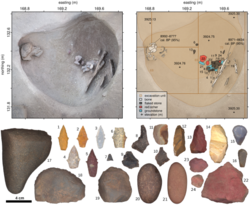
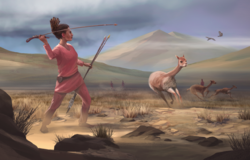
The burial assemblage is by far the richest of the burials excavated at Wilamaya Patjxa and the nearby site of Soro Mik'aya Patjxa. The toolkit likely represents a large-mammal hunting toolkit.[15] Five complete projectile points were likely used to dispatch large mammals including vicuña and taruca as indicated by the site's faunal assemblage. Microscopic examination of the projectile points confirm that they were indeed used as projectile points and not solely as knives or grave goods. The other tools in the kit include stone hide scrapers, flakes, a knife, choppers, cobbles, and red ocher, all of which were likely used for animal processing.[16] The association of large-mammal hunting tools with a female individual suggests that the individual was likely a hunter.[17] This conclusion follows from a previous cross-cultural study, which found that the tools people used in life tend to be those that accompany them to the grave.[18]
Stable oxygen isotope readings from the bone indicate that Warawara was a permanent resident of the highlands. Stable carbon and nitrogen isotope readings show that they consumed a mixed diet of plants and animals.[19]
Phaxsi
Phaxsi was an adult male ceremoniously interred 9,000 years ago at the site of Wilamaya Patjxa.[20] Phaxsi is the name Aymara community members gave to the individual initially identified as burial Individual 1 (WMP 1). The name means "moon" in Aymara language.
A radiocarbon date on bone collagen establishes that the burial occurred sometime between 9,000–8,700 years ago and thus was roughly contemporaneous with Warawara.[21] Proteomic and osteological analyses shows that Phaxsi was male and approximately 25–30 years old at the time of death.[22]
The individual was associated with two projectile points, though it is unclear if the artifacts were funerary objects or homicide weapons. Microscopic examination of the projectile points confirm that both artifacts were used as projectile points and that one was also used as a knife.[23]
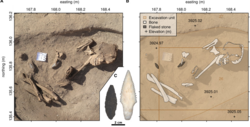
Stable oxygen isotope readings from the bone indicate that Phaxsi was a permanent resident of the highlands. Stable carbon and nitrogen isotope readings show that they consumed a mixed diet of plants and animals.[25]
History of investigation
During the 2013 excavations of Soro Mik'aya Patjxa, Albino Pilco Quispe (Aymara community of Mulla Fasiri and long-time archaeology collaborator) informed archaeologist, Randy Haas (University of Wyoming) of an artifact concentration on his agricultural land in Mulla Fasiri.[26] Inspection of the artifacts revealed that the site had an Early Archaic Period (11.7--9.0 ka) component and thus potential to reveal insights into the earliest human populations of the Titicaca Basin. With support from the University of California, Davis, archaeologists and members of the community of Mulla Fasiri conducted excavations in 2018 and 2019. The site derives its name from the Aymara name of the land on which it occurs.
Media coverage
The findings at Wilamaya Patjxa received widespread media coverage from hundreds of news outlets[27] including the New York Times,[28] El País,[29] National Geographic,[30] and National Public Radio.[31] National Geographic wrote that "Prehistoric female hunter discovery upends gender role assumptions".[32] Forbes concluded, "Don’t Blame Gender Inequity On Our Ancestors, Ancient Women Were Big-Game Hunters Too".[33] The New York Times reported that "Ancient Remains in Peru Reveal Young, Female Big-Game Hunter" but "Scientists are divided on broader implications of the find for ancient gender roles".[34] UC Davis Unfold podcast declared, "she was a badass"[35]
See also
- Jiskairumoko
- Qillqatani
- Soro Mik'aya Patjxa
Notes
- ↑ Haas et al. 2020
- ↑ Lindo et al. 2018
- ↑ Haas et al. 2020
- ↑ Lindo et al. 2018
- ↑ Aldenderfer 2006; Haas 2023
- ↑ Haas et al. 2020; Smallwood et al. 2023
- ↑ Smallwood et al. 2023
- ↑ Bebber et al. 2023; Ocobock and Lacy 2023; Lacy and Ocobock 2023; Anderson et al. 2023
- ↑ Kelly 2013
- ↑ Ministerio de Cultura 2021
- ↑ Haas et al. 2020
- ↑ Haas et al. 2020
- ↑ Haas et al. 2020
- ↑ Haas et al. 2020
- ↑ Smallwood et al. 2023
- ↑ Smallwood et al. 2023
- ↑ Haas et al. 2020
- ↑ Binford 1971
- ↑ Haas et al. 2020
- ↑ Smallwood et al. 2023
- ↑ Smallwood et al. 2023
- ↑ Haas et al. 2020
- ↑ Smallwood et al. 2023
- ↑ Haas et al. 2020
- ↑ Haas et al. 2020
- ↑ Haas et al. 2020
- ↑ Altmetric 2023
- ↑ Gorman 2020
- ↑ Ángel Criado 2020
- ↑ Wei-Haas 2020
- ↑ Lim 2020
- ↑ Wei-Haas 2020
- ↑ Elsesser 2020
- ↑ Gorman 2020
- ↑ Quinton and Kerlin 2021
References
- Aldenderfer, Mark S. (2006) "Modelling plateau peoples: the early human use of the world's high plateaux." World Archaeology 38(3):357–370. doi:10.1080/00438240600813285
- "Altmetric: Female hunter's of the early Americas". Retrieved 31 October 2023.
- Anderson, Abigail; Chilczuk, Sophia; Nelson, Kaylie; Ruther, Roxanne; Wall-Scheffler, Cara (2023) "The myth of man the hunter: women's contribution to the hunt across ethnographic contexts." PLoS ONE 18(6):e0287101. doi:10.1371/journal.pone.0287101.
- Ángel Criado, Miguel (2020) "Las mujeres prehistóricas también cazaban grandes animales." El País. Retrieved 31 October 2023.
- Binford, Lewis R. (1971) "Mortuary practices: their study and their potential". Memoirs of the Society for American Archaeology 25:6--29. doi:10.1017/s0081130000002525.
- Elsesser, Kim (2020) "Don’t Blame Gender Inequity On Our Ancestors, Ancient Women Were Big-Game Hunters Too." Forbes. Retrieved 31 October 2023.
- Gorman, James (2020) "Ancient Remains in Peru Reveal Young, Female Big-Game Hunter." Trilobites, New York Times. Retrieved 31 October 2023.
- Haas, Randall (2023) "Early settlement of the High Andes." Oxford Research Encyclopedia. doi:10.1093/acrefore/9780190854584.013.444
- Haas, Randall; Watson, James; Buonasera, Tammy; Southon, John; Chen, Jennifer C.; Noe, Sarah; Smith, Kevin; Viviano Llave, Carlos; Eerkens, Jelmer; Parker, Glendon. "Female hunters of the early Americas". Science Advances. American Association for the Advancement of Science (AAAS). 6 (45): eabd0310. doi:10.1126/sciadv.abd0310.
- Lacy, Sarah; Ocobock, Cara (2023) "Woman the hunter: The archaeological evidence." American Anthropologist. doi:10.1111/aman.13914.
- Lim, Alexa (2020) "Ancient Big Game Hunters May Have Included Women." Science Friday, National Public Radio. Retrieved 31 October 2023.
- Lindo, John; Haas, Randall; Hofman, Courtney; Apata, Mario; Moraga, Mauricio; Verdugo, Ricardo A.; Watson, James T.; Viviano Llave, Carlos; Witonsky, David; Beall, Cynthia; Warinner, Christina; Novembre, John; Aldenderfer, Mark; Di Rienzo, Anna (2018). "The genetic prehistory of the Andean highlands 7000 years BP though European contact". Science Advances. American Association for the Advancement of Science (AAAS). 4 (11): eaau4921. doi:10.1126/sciadv.aau4921.
- Kelly, Robert L. (2013) The lifeways of hunter-gatherers: the foraging spectrum. Cambridge University Press.
- Ministerio de Cultura, Peru (2021) Resolución Viceministerial N° 000281-2021-VMPCIC/MC.
- Ocobock, Cara; Lacy, Sarah (2023) "Woman the hunter: The physiological evidence." American Anthropologist. doi:10.1111/aman.13915.
- Quinton, Amy; Kerlin, Kat (2021) "*Was* She a Badass?" UC Davis Unfold Podcast. Retrieved 31 October 2023.
- Smallwood, Ashley; Haas, Randall; Jennings, Thomas (2023) "Lithic usewear analysis confirms the function of Wilamaya Patjxa projectile points." Scientific Reports 2023. doi:10.1038/s41598-023-45743-7.
 |

